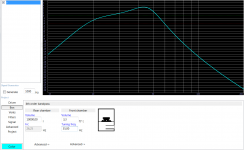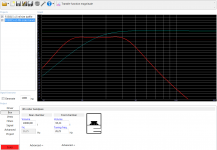Hello Everyone!
First time on the forum because I cannot find an answer for this anywhere.
I plan to use a Fi IB3 15 in my regular cab tacoma (2 door, 1 row of seats). I calculated all the parameters to build a nice 4th order bandpass box for the bed. Obviously this means one sealed chamber and one ported chamber that will connect through to the cab. My question is what will happen if I eliminate the sealed chamber????
As an infinite baffle woofer I know it would work if I just directly mounted it in the wall of the cab. In this instance front wave and back wave are separated. But I don't want to cut a hole that big in my truck. So what if I essentially made a ported box for the sub and the front wave was lost to the outside of the truck, but then I took the back wave through a port and into the cab? (Half of a bandpass box)
Hope this makes some amount of sense. Thanks in advance for your input!!!!!
First time on the forum because I cannot find an answer for this anywhere.
I plan to use a Fi IB3 15 in my regular cab tacoma (2 door, 1 row of seats). I calculated all the parameters to build a nice 4th order bandpass box for the bed. Obviously this means one sealed chamber and one ported chamber that will connect through to the cab. My question is what will happen if I eliminate the sealed chamber????
As an infinite baffle woofer I know it would work if I just directly mounted it in the wall of the cab. In this instance front wave and back wave are separated. But I don't want to cut a hole that big in my truck. So what if I essentially made a ported box for the sub and the front wave was lost to the outside of the truck, but then I took the back wave through a port and into the cab? (Half of a bandpass box)
Hope this makes some amount of sense. Thanks in advance for your input!!!!!
Yes that will work. You can simulate it as a 4th order bandpass with a 'large' closed chamber. 1000 L will work.
Last edited:
Yes that will work. You can simulate it as a 4th order bandpass with a 'large' closed chamber. 1000 L will work.
So would I calculate the port As IF it were a 4th order? Or would I calculate tuning like a regular ported box?
In 4th order I know the front chamber is the “filter”. In my initial calculations I came out with a front chamber approx 3.3 cubic feet with a round port tuned to 35hz.
If I were to build this as a regular ported design I would tune to 23 Hz because I want a lowww sound. So do I still use 4th order logic?
Calculate it as if it were a 4th order bandpass. You have two variables: port tuning frequency and front chamber volume.
-The port tuning frequency sets the center of the bandwidth and the ratio between high and low bass. For a flat response, it is tuned to the resonance frequency of the woofer in the rear chamber, which is fs in your case (26 Hz). That will result in an impractically long port.
- The front chamber volume sets the compromise between bandwidth and efficiency.
Cabin gain tends to boost low bass, so you might want to compensate for that a bit by tuning higher.
With a 3.3 cu. ft. front chamber volume and 35 Hz tuning the sub will only play up to 50 Hz. Does that work for you? Alternatively, you could leave out the port and front chamber and build a simple infinite baffle setup and let the woofer fire through a hole.
-The port tuning frequency sets the center of the bandwidth and the ratio between high and low bass. For a flat response, it is tuned to the resonance frequency of the woofer in the rear chamber, which is fs in your case (26 Hz). That will result in an impractically long port.
- The front chamber volume sets the compromise between bandwidth and efficiency.
Cabin gain tends to boost low bass, so you might want to compensate for that a bit by tuning higher.
With a 3.3 cu. ft. front chamber volume and 35 Hz tuning the sub will only play up to 50 Hz. Does that work for you? Alternatively, you could leave out the port and front chamber and build a simple infinite baffle setup and let the woofer fire through a hole.
Attachments
1000 L will work.
FWIW, in a similar discussion w/ Altec way back when: > 10x Vas for IB, > 4x for 'close enough'.
GM
Calculate it as if it were a 4th order bandpass. You have two variables: port tuning frequency and front chamber volume.
-The port tuning frequency sets the center of the bandwidth and the ratio between high and low bass. For a flat response, it is tuned to the resonance frequency of the woofer in the rear chamber, which is fs in your case (26 Hz). That will result in an impractically long port.
- The front chamber volume sets the compromise between bandwidth and efficiency.
Cabin gain tends to boost low bass, so you might want to compensate for that a bit by tuning higher.
With a 3.3 cu. ft. front chamber volume and 35 Hz tuning the sub will only play up to 50 Hz. Does that work for you? Alternatively, you could leave out the port and front chamber and build a simple infinite baffle setup and let the woofer fire through a hole.
You are an absolute god send. Thanks so much for the help. I’m thinking I shoot for that flat response wave by tuning to 26hz. I used Lv = ((94250 * R^2) / (fb^2 * Vf)) – (1.595 * R). So with a 4 inch round port R=5.08cm I got a length of 30.2 cm or 11.88 inches.
I would use flared ends to avoid chuffing. Can you run this in your model and see how it looks. Box volume is 95.23L.
Flaring is a good idea.
4th order bandpass, infinite rear chamber, 95.23 L front chamber tuned at 26 Hz:
-3 dB response is from 14 to 48 Hz. That will boom hugely if you factor in cabin gain. With a 4" (10.2 cm) port and 500 W of power the air speed inside the port will be 48 m/s at 20 Hz which is way too much. With a 15 cm diameter diameter port 😱 it is 22 m/s. That port would have a length of 70 cm. If it's too boomy, you can shorten the port to get more 'upper' bass (50 - 60 Hz). You would need separate kick bass units to cover say 48 - 150 Hz.
I would go for an infinite baffle setup and let the woofer fire through a hole as large as you can cut. That will remove the need for kick bass units playing down to 48 Hz as the woofer can play up to a higher frequency, result in a smaller 'cabinet' (as there is none really) and removes the need to fit a large port. See attachment, red is bandpass and cyan is infinite baffle.
4th order bandpass, infinite rear chamber, 95.23 L front chamber tuned at 26 Hz:
-3 dB response is from 14 to 48 Hz. That will boom hugely if you factor in cabin gain. With a 4" (10.2 cm) port and 500 W of power the air speed inside the port will be 48 m/s at 20 Hz which is way too much. With a 15 cm diameter diameter port 😱 it is 22 m/s. That port would have a length of 70 cm. If it's too boomy, you can shorten the port to get more 'upper' bass (50 - 60 Hz). You would need separate kick bass units to cover say 48 - 150 Hz.
I would go for an infinite baffle setup and let the woofer fire through a hole as large as you can cut. That will remove the need for kick bass units playing down to 48 Hz as the woofer can play up to a higher frequency, result in a smaller 'cabinet' (as there is none really) and removes the need to fit a large port. See attachment, red is bandpass and cyan is infinite baffle.
Attachments
Last edited:
- Status
- Not open for further replies.
- Home
- Loudspeakers
- Subwoofers
- 4th Order Bandpass, Can I eliminate rear chamber?

